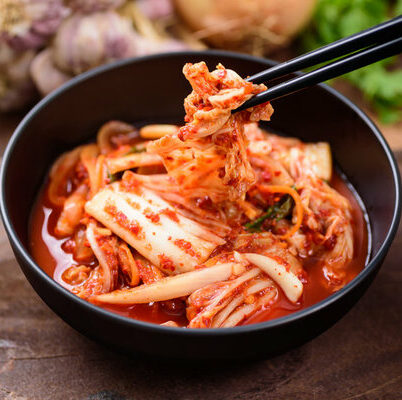
Kimchi Juice
What is Kimchi Juice?
Kimchi juice is a by-product of the fermentation process while making kimchi, which is made from fermented vegetables, fish sauce, and a mix of spices. The brine has a salty, spicy, and tangy flavor, similar to that of kimchi and is often used to flavor dishes.
- Some Koreans deliberately prepare the recipe in a way that gives out more kimchi juice, which is then used in a variety of other dishes.
- Kimchi juice is often used to spice up stews, ramen, fried rice, stir-fries, and even added to beverages and cocktails.
Some popular ways to use kimchi juice in the kitchen include:
- Pickled Vegetables
- Condiments
- Cocktails
- Dips
- Kimchijeon
- Fried Rice
- Chili Beans
- Marinades
- Soondubu-jjigae
- Pasta
- Eggs
- Soups
- Shakshuka
- Meat
- Kimchi
Origin of kimchi juice
Kimchi originated in Korea over 3,000 years ago. Originally, the fermentation method began as a way to store vegetables during the cold winters when starvation was rampant. In ancient Korea, the production of kimchi required burying it in earthen or stone jars. However, in the summertime, it was hung deep inside wells to keep it cool. The dish spread to Europe, Africa, and America via Korean immigrants. In recent years, kimchi and kimchi juice have gained more popularity outside of Korea.
Nutrition
Nutritional profile for kimchi juice (1 serving):

Kimchi juice has similar micronutrients as the kimchi it was made in. Therefore, kimchi juice is rich in vitamins such as choline, folate, niacin, riboflavin, thiamin, vitamin A, vitamin B6, and vitamin K. Also, it is full of minerals like iron and sodium. Kimchi possesses antioxidant and anti-inflammatory properties.
Moreover, kimchi is a probiotic and contains lactic acid bacteria, which is essential for digestion and gut health. It prevents gastrointestinal diseases such as irritable bowel syndrome, reduces cholesterol, and inflammation. In addition, it can help prevent certain types of cancers, cardiovascular diseases, metabolic syndrome risks, and aging. Additionally, there is some evidence that consuming kimchi may help in preventing diabetes.
Commercial production
The production of kimchi begins when cabbage (and/or other vegetables) are washed and sliced into small pieces. Then, salt is added and left in to soak for 3 hours during the brining process. To ensure more juice, the brining process should be shorter. After that, the cabbage is rinsed and drained. Next, ginger, garlic, fish sauce, shrimp paste, and water are mixed into a smooth paste, to which the chili powder is added.
Then, the cabbage is added to the paste, and radish and scallions are added as well. After that, everything is mixed thoroughly and then sealed in a jar, leaving some space at the top for fermentation. The mixture is allowed to ferment for at least five days. Only fermented products may be called kimchi. Together with the pickled vegetables, kimchi juice is also produced.
Kimchi and kimchi juice may be stored for several months in a jar or a crock with a lid in the refrigerator.
Kimchi recipes
This is added to different dishes to provide a sour and tangy flavor. It is especially good when paired with Korean dishes or with other hearty dishes that require a spicy flavor profile. Here are some recipes to try:
- Kimchi Bokkeum-bap
- Kimchi Jjigae
- Soondobu Jjigae
- Kimchi Jun
- Kimchi Guk
- Kimchi Gibson
- Noodle Stir-Fry
- Kimchi Micheladas
- Sweet Potato and Kale Tacos
- Kimchi Quinoa Bowls
- Kimchi Bloody Mary
FDA regulations
According to the FAO, kimchi is a product prepared by fermenting varieties of Chinese cabbage and seasoning mixture mainly consisting of red pepper powder, garlic, ginger, edible Allium varieties other than garlic, and radish. Different states in the US have different laws on selling fermented products. Currently, there is no standard of identity for kimchi juice.
References
Dai-Ja Jang, Kyung Rhan Chung, Hye Jeong Yang, Kang-sung Kim, Dae Young Kwon, Discussion on the origin of kimchi, representative of Korean unique fermented vegetables, Journal of Ethnic Foods, Volume 2, Issue 3, 2015, Pages 126-136, ISSN 2352-6181, https://doi.org/10.1016/j.jef.2015.08.005., https://www.sciencedirect.com/science/article/pii/S2352618115000451
Patra, Jayanta Kumar et al. “Kimchi and Other Widely Consumed Traditional Fermented Foods of Korea: A Review.” Frontiers in microbiology vol. 7 1493. 28 Sep. 2016, doi:10.3389/fmicb.2016.01493, https://www.frontiersin.org/articles/10.3389/fmicb.2016.01493/full
Kim, Myung-Sunny et al. “Effects of Kimchi on human health: A protocol of systematic review of controlled clinical trials.” Medicine vol. 97,13 (2018): e0163. doi:10.1097/MD.0000000000010163, https://www.ncbi.nlm.nih.gov/pmc/articles/PMC5895381/
